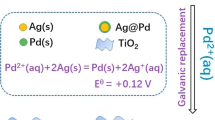Abstract
Synthesis of trioctylamine by the amination of octanol and ammonia under atmospheric pressure over an excellent Ni–Cu catalyst supported on diatomite is studied in this article. The key factor for the synthesis is the preparation of catalyst with a high activity and selectivity. The activity and selectivity can be adjusted by varying the Ni to Cu ratios. The optimum molar ratio of Ni to Cu was 1.25:1. For the catalyst with a Ni/Cu ratio of 1.25:1, the conversion of octanol and the selectivity of trioctylamine reached 100 and 97.3%, respectively, at 5 h. The reaction of dioctylamine with octanol was the rate-determining step for the formation of trioctylamine. The Physical properties of catalysts, such as particle size, Brunauer–Emmett–Teller (BET) surface area, valence state of catalyst elements, morphology and reduction properties of catalysts were investigated by using X-ray diffraction, nitrogen adsorption–desorption isotherms (BET), X-ray photoelectron spectroscopy, Transmission electron microscopy, and temperature programmed reduction, respectively. The reaction scheme of catalytic amination of octanol with ammonia was discussed.
Graphical Abstract










Similar content being viewed by others
References
Li QX, Zhang GY, Peng SY (2002) J Surfactants Deterg 5:229
Abe H, Taniguchi H, Okabe K, Sotoya K (1989) Yushi 38:565
Kimura H, Taniguchi H (2005) Appl Catal A 287:191
Li QX, Zhang GY, Peng SY (2001) Chin J Catal 22:7
Li QX, Zhang GY, Peng SY (2001) Chin J Appl Chem 18:693
Okibe K, Abe H, Yokota Y (1989) Stud Surf Sci Catal 44:299
Baiker A, Caprez W, Hoistein W (1983) Ind Eng Chem Prod Res Dev 22:217
Abe H, Hashiba K, Yokota Y, Okabe K (1988) Yushi 37:519
Li QX, Zhang GY, Peng SY (2003) Fine Chem 32:151
Kimura H, Matsutani K, Tsutsumi S (2005) Catal Lett 99:119
Abe H et al (1989) J Jpn Oil Chem Sci 38:94
Li QX et al (1999) China Surfactant Deterg Cosmet 2:33
Kimura H et al (2005) Catal Lett 99:133
Tlusty T, Pasek J, Vonka P (2006) React Kinet Catal Lett 88:371
Kimura H, Tsutsumi S, Tsukada K (2005) Appl Catal A 292:281
Fischer A, Mallat T, Baiker A (1997) Catal Today 37:167
Yamakawa T, Tsuchiya I, Mitsuzuka D, Ogawa T (2004) Catal Commun 5:291
Cangiano M De los A, Ojeda MW, Carreras AC, et al (2010) Mater Character 61:1135
Tak-Hyun K, Min J, Jae Kwang P (2008) Microporous Mesoporous Mater 108:22
Brunauer S, Emmett PH, Teller E (1938) J Am Chem Soc 60:309
Barrett EP, Joyner LG, Halenda PP (1951) J Am Chem Soc 73:373
Abe H, Hoshi S, Domen K et al (1990) Chem Lett 19:401
Wang QW, Yang JL, Ren JF et al (1990) Catal Lett 4:63
Robertson SD, Mc Nicol BD, De Baas JH et al (1975) J Catal 37:424
Li QX (2003) Institute of Coal Chemistry, Chinese Academy of Sciences as a requirement for admission to the degree of Ph.D., pp 44–45
Acknowledgments
The authors would like to thank China Research Institute of Daily Chemical Industry for fund support and the publication of the present study.
Author information
Authors and Affiliations
Corresponding author
Rights and permissions
About this article
Cite this article
Li, Y., Li, Q., Zhi, L. et al. Catalytic Amination of Octanol for Synthesis of Trioctylamine and Catalyst Characterization. Catal Lett 141, 1635–1642 (2011). https://doi.org/10.1007/s10562-011-0686-z
Received:
Accepted:
Published:
Issue Date:
DOI: https://doi.org/10.1007/s10562-011-0686-z




